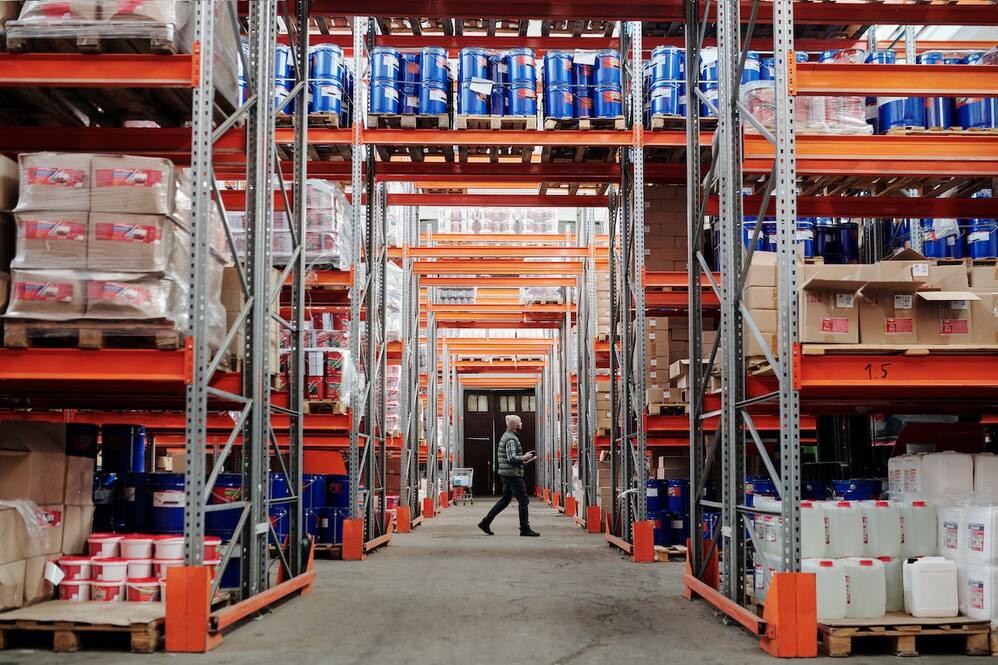Wholesale distribution systems facilitate the distribution of products to customers.
Knowing those systems and how they can best serve your business is crucial to maximizing profits and staying ahead of the game.
In this ultimate guide, we’ll go over everything you need to know about:
- How wholesale distribution systems work.
- How to use software to optimize your distribution system.
What are wholesale distribution systems?
Wholesale distribution systems are the different methods, vendors, and networks that a wholesaler uses to get its product to a customer.
The purpose of wholesale distribution systems is to facilitate the marketing, transportation, and delivery of goods or products to the end consumer.
Types of wholesale distribution systems
Wholesale systems of distribution can be classified in a few different ways, including:
- Business-to-business (B2B): In a B2B wholesale system, the wholesaler sells to retailers that then resell to customers.
- Direct-to-consumer (D2C): In a D2C system, the wholesaler sells its products directly to the consumer.
- E-distribution: In this system, products are available for purchase directly from the wholesaler via an online platform.
What is a distribution channel?
A distribution channel is part of downstream operations, the chain of businesses a product goes through from production to end consumer.
Traditional distribution channels encompass manufacturers, wholesalers, retailers, and consumers.
Modern channels of distribution that are increasingly common nowadays include e-commerce and drop-ship distribution.
Types of distribution channels
In the distribution of a product, there are three main channels: direct, indirect, and hybrid.
All channels involve one or more distribution system participants or intermediaries. Those intermediaries are manufacturers, wholesalers, retailers, and end consumers.
Let’s look at the three main distribution channels and examples of how businesses use them.
Direct channels
In direct channels, the producer sells directly to the customer without using other distribution system participants.
A product that goes through a direct channel takes the shortest route to the consumer. For example, a manufacturer that makes industrial machinery sells them directly to the customer.
Another example is the automobile industry – car manufacturers that sell their cars to customers through their stores use a direct channel.
Indirect channels
Indirect channels use one or more intermediaries to get a product to the end consumer.
Most consumer products use indirect distribution channels comprising manufacturers, wholesalers, and retailers.
The healthcare industry typically uses indirect distribution channels for pharmaceutical distribution.
For example, a pharmaceutical company may get its product to the customer via the wholesale market, selling its products to a wholesale company in bulk.
Then, the wholesaler finds retailers and sells the product to them for resale. Finally, the retailer, such as a pharmacy, sells the product to end consumers.
Hybrid channels
Hybrid distribution channels use direct and indirect channels to get products to the end consumer.
A company that sells directly to customers and other businesses or retailers uses hybrid distribution channels.
For example, a manufacturer producing clothing might sell directly to customers through their website. At the same time, the manufacturer may sell to wholesalers that resell the clothes at wholesale prices to retailers.
What is the difference between direct and indirect distribution channels?
The difference between direct and indirect distribution channels is how the product reaches the customer.
A manufacturer that sells directly to the consumer uses direct channels. In contrast, indirect channels use intermediaries to get the product to the end consumer.
One example of a direct channel is a brewery that makes craft beer on-site and sells it directly to the customer.
An example of indirect distribution is the wine and adult beverages industry.
Due to laws still in place from the Prohibition Era, manufacturers in this industry aren’t allowed to sell alcoholic beverages directly to customers. Instead, they must sell to wholesalers.
The retailers then purchase alcoholic beverages at wholesale prices and resell them to customers.
Choosing the right distribution channel
The right distribution channel for companies largely depends on the industry the company operates in and what products it sells.
A company should determine the most profitable and efficient ways to get its products to end consumers.
Let’s look at some distribution sectors or channels and which companies benefit from using them.
Producer > consumer
In this type of system, the most prevalent distribution methods are:
- On-site sales counter.
- Door-to-door sales.
- Mechanical device sales (i.e., vending machines).
Producer to consumer is most suitable for:
- Perishable goods in (i.e., catering).
- Products sold by mail.
- Industrial goods that require manual intervention.
Producer > retailer > consumer
In this type of system, the main distribution methods are:
- Postal orders.
- Sales directly from the factory.
- A retailer purchasing directly from the producer.
Producer to retailer to consumer is best suited for:
- Perishable products (e.g., food and fashion products).
- Large retailers dealing directly with producers.
Producer > wholesaler > retailer > consumer
In this system, the main distribution method is via wholesalers and retailers.
It’s best suited for:
- Products needing proportional distribution.
- Goods sold in widely scattered areas.
- Large quantities of produced goods purchased in limited amounts.
The essential features of a wholesale distribution system
Distribution software has critical features that help wholesale distributors with a wide range of operations, such as customer relationship management (CRM) and sales fulfillment.
Some essential features of a wholesale distribution system include:
- Purchase optimization.
- Logistics management.
- Order fulfillment.
- Inventory management and tracking.
Why implement a wholesale distribution system?
Implementing a wholesale distribution system is vital for companies wanting to get ahead of the wholesale market.
Distribution software acts as an automatic product distribution system in that it automates many of the tedious processes involved in wholesale distribution, including:
- Invoicing.
- Procurement.
- Stock tracking.
According to Forbes, wholesale distributors must adopt innovative software solutions to compete in an ever-shifting economy.
A wholesaler that uses distribution management systems or software will be more resilient and better equipped for the future.
What are the benefits of wholesale distribution systems?
The benefits of wholesale distribution systems include increased visibility, optimized inventory management, and improved operations:
- Increased visibility: Distribution software increases visibility through a centralized platform that keeps track of operations and workflows. This platform lets you view operations in real-time, including stock levels, task assignments, order fulfillment status, etc.
- Optimized inventory management: Wholesale distribution software provides access to automated inventory tools for inventory management. This includes paperless transactions and detailed inventory tracking over multiple locations.
- Improved operations: Wholesalers using distribution software can keep track of procurement, picking and packing, dispatching, shipping, and other essential processes.
Who should use a wholesale distribution system?
Wholesale distribution software is most helpful to wholesalers who want to simplify their distribution service with a software solution.
Other companies that want to stay competitive through digitizing distribution processes can also resort to wholesale distribution systems.
Wholesale distributors have to keep track of multiple systems simultaneously, including:
- Sourcing products from manufacturers.
- Optimizing delivery.
- Managing supply chains.
- Staying on top of customer relationships.
Wholesale distributors often use multiple platforms for managing parts of a central distribution system and manual documentation, such as spreadsheets. But this can increase operational costs, compliance costs, and time spent working the separate systems.
In the worst case, errors made in one system might affect other systems, causing severe congestion in supply or delivery.
Wholesale distributors can avoid these additional costs and problems with a software solution, which makes it easy to manage all the moving parts of the business on a single distribution system platform.
How do I get started with wholesale distribution systems?
You can start with wholesale distribution systems by first examining which distribution system is a good fit for your business and industry, whether B2B, D2C, e-commerce, or other systems.
Then, find the software solution that’s the best fit.
Distribution software that offers an all-in-one software solution is the simplest, quickest way to solve the challenges that distributors face.
An all-in-one software provides everything you need to manage operations, including inventory, workflow, and customer relationship management.
One of the best options for an all-in-one software solution is Method CRM, a fully customizable platform with everything a wholesale distributor needs to:
- Close more sales.
- Enhance customer relationships.
- Simplify distribution workflows.
Method’s platform offers many essential features for wholesale distributors, such as advanced inventory management, workflow automation, and a two-way sync with the accounting platform QuickBooks.
How to set up a wholesale distribution system
To set up a wholesale distribution system, you must:
- Determine who your customers are and how you’ll get your product to them. Ask why and where they’ll buy your product.
- Choose which distribution channels are best for your business. Are you selling directly to your customers? Or will your product go through intermediaries that are purchasing for resale?
- Find and establish business relationships with the intermediaries you need, and sign agreements with them.
- Even after the system is set up, monitoring and optimizing your distribution network is essential.
Always look for ways to make it more efficient and re-examine if it’s the best way to get your products to your customers.
Key takeaways
Wholesale distribution systems, whether B2B or D2C, help wholesalers define the customers they’re selling to, while distribution channels are the intermediaries involved in the distribution of the product.
Choosing efficient systems and channels of distribution is essential because it’s the core of how your products will reach your customers.
While many wholesalers use different software to manage operations, implementing an all-in-one software solution is the best way to maximize profits and remain competitive.
The best all-in-one solution needs to handle critical operations for wholesalers, such as:
- Inventory tracking and management.
- Logistics management.
Method CRM is a top-performing CRM platform that can handle all that (and more). Method offers a fully-customizable platform you can tailor to your business’s unique needs.
Get top-rated features like advanced inventory management and QuickBooks or Xero sync in a single centralized solution.
Wholesale distribution systems FAQs
What is an example of wholesale distribution?
An example of wholesale distribution is when a wholesaler buys products from a manufacturer in bulk and sells them to retailers or consumers at wholesale prices.
What is a wholesale management system?
A wholesale management system is a tool wholesalers use to manage and optimize distribution workflows and processes.
What is distribution management system software?
Distribution management software is a program or platform that assists distributors in getting products to customers efficiently. Distribution software typically includes features like sales order management, supply chain management, transportation and warehouse management, and CRM.
Claim your free trial of Method CRM now!
Image credit: Tiger Lily via Pexels






